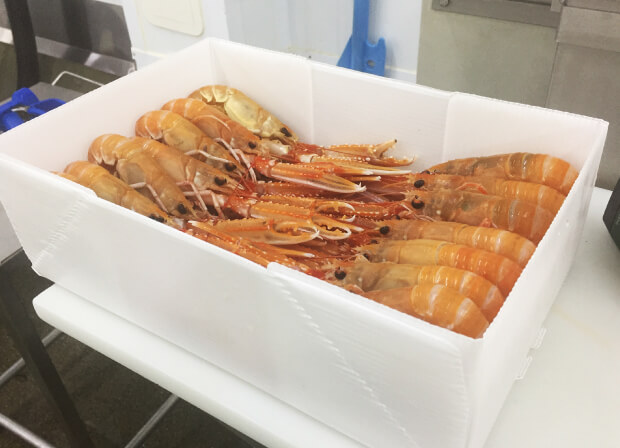In recent years, however, sustainability has become an ever growing factor across all industries when packaging of any kind is concerned. More sustainable materials, and recyclability are key factors that continue to impact buying decisions. And this is no different for seafood packaging and the fishing industry.
Packaging has come a long way in recent years when it comes to sustainability, and so too has the options available for seafood packaging. Whilst polystyrene, or EPS, is still the most used material for fish boxes and seafood packaging, there is a shift being made towards more sustainable materials. The industry now has a range of tried and tested options for packing and distributing seafood…
Polystyrene
Historically polystyrene or EPS (expanded polystyrene) has been the material of choice when it comes to seafood packaging. But when it comes to sustainability, there aren’t many plus points for polystyrene as a material.
Although as a material it can be recycled through a specialist process, it is estimated more than 50% of all EPS fish boxes end up in landfill. Furthermore, as a material that degrades easily in water, it is also a significant contributor to marine plastics too. Not ideal, therefore, for seafood packaging and an industry that relies on the marine environment.
With a high-energy manufacturing process, and higher CO2 impact than other materials to transport, there aren’t many sustainability boxes polystyrene ticks. In fact, with many single use polystyrene items already banned, is it only a matter of time before the material is banned across the board completely?
Waxed cardboard
When it comes to packaging materials, cardboard is always viewed as a more eco-friendly, sustainable option. In order to use the material effectively for seafood packaging, the problem of moisture and structural integrity has to be countered with lining the cardboard – in this case with wax.
Whilst the perception is that cardboard is a greener, more sustainable material for fish boxes, it is a surprise to many that waxed cardboard cannot in fact be recycled here in the UK. Any paper or cardboard that is coated – whether that is with plastic, wax or even foil – can’t be recycled. The perception from many within the seafood sector is that having switched their seafood packaging from polystyrene over to card they have made a more sustainable choice, but with waxed cardboard there is no option for recycling of what is already an energy intensive material to manufacture.
Polypropylene
Plastic is often seen as a ‘bad’ material when it comes to sustainability. Whereas single use plastics are an ongoing problem for consumer goods, there is a distinction that should be made between single use plastics and plastics that can be recycled time and time again – those that contribute towards a closed loop, circular economy.
Polypropylene is a lightweight, fluted plastic that provides comparable insulation to polystyrene and can be shipped flat packed which has additional sustainability gains from a CO2 perspective. The biggest plus point when it comes to comparing both polystyrene and waxed cardboard for seafood packaging is the ease at which polypropylene can be recycled – with the ability to be disposed of as part of your everyday kerbside recycling. With polystyrene requiring specialist collection and recycling, and waxed cardboard not having the ability to be recycled, polypropylene has a surprisingly significant advantage here when compared to other seafood packaging materials.
Returnable
In addition to the above materials, some businesses can look at operating returnable plastic trays. Although these boxes have the potential to be reused many times, this does not always work in practice and is not always an option for every business – dependent entirely on the supply chain. Many companies that implement a returnable box option, quickly lose a high percentage of boxes and have to rebuy and replenish stock regularly.
Although the intention of switching to returnable trays does offer sustainability benefits, in practice it is often far from easy to manage and results in more plastic boxes being bought and not used than if you use a recyclable option to begin with.
What is the best seafood packaging for your business? In addition t
No two seafood businesses are the same, and many have challenges from storage, to transport, from disposal to cost – which choosing the right seafood packaging can help solve.
As a manufacturer of Coolseal Seafood Packaging – made from polypropylene – we are always happy to discuss the sustainability benefits of our boxes and how we can help your seafood operations reduce transport and storage costs.
If you would like to know more about our range of seafood packaging, get in touch today to talk about the benefits for your seafood operations.
